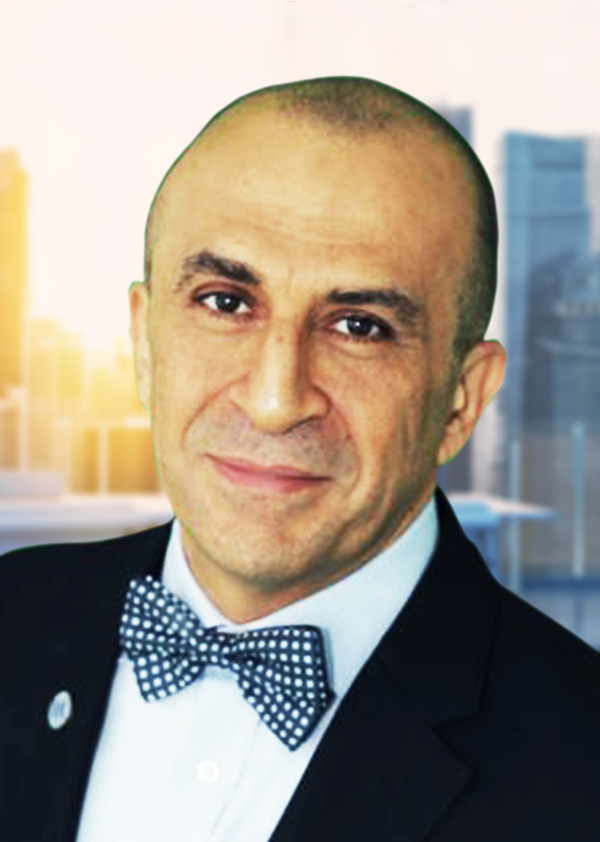Dr. Banana and Dr. Vader: Experts in Assessment and Selection

I am often asked by clients "what is the best way to select candidates after they have applied to an organization?"
For years, I have tried to come up with the right answer, to convince myself first before convincing others. The result has always been unsatisfying – that is to say, until I went to a hospital for my special 'midlife' medical checkup! That's when I discovered that hospitals make great assessment and selection role models, and if you really want to adopt a perfect selection process, all you need to do is go through a full medical checkup.
A couple of days before the due date, I received a call from someone who reminded me about the need to fast for 12 hours before going to the clinic. The caller also stressed the importance of bringing running gear (shoes and shorts) and a designated driver: "You won’t be able to drive back home on your own because you will most likely be tired!" he said.
On the designated day, my wife took me there and we arrived half an hour early. Upon reaching the clinic, we were welcomed by a nurse who did not waste any time in asking me to fill a 2 page application. The form included standard questions about biometrics (age, weight and height) and other questions about lifestyle (smoker/nonsmoker, active/not active, single/married, etc.).
I filled the form and handed it to the nurse who glanced at it and returned to me while asking for my signature. I signed and dated the form and gave it back to her at which point she asked me to follow her to a small examination room. Inside, she took my height and weight and with a smirk, crossed the numbers I had written on the form and entered her own. Apparently (inadvertently, I swear!), I had added an inch to my height and subtracted a couple of pounds from my weight!
The nurse then took my blood pressure and temperature, wrote them down and headed towards the door. As she was leaving, she said "the doctor will be with you in 5 minutes."
As if the whole thing was choreographed, exactly five minutes later, a young doctor in his mid-thirties, walked in with a smile wider than a banana. "Good morning Mr. Taher. I am Dr. Emad and I am here to find out a little bit more about you and why you are doing this. I also would like to explain to you the process you will be going through today, but before doing anything, let us get your blood and other samples so you can break your fast and have some juice and a bite. You will need to be ready for later today."
The session with Dr. Banana, including the blood sampling and a visit to the bathroom, took 30 minutes. During the chat, he found out why I was subjecting myself to such a thorough checkup and I, on the other hand, found out just how thorough the checkup was going to be (and how expensive!). Apparently, the 5 hours I was planning on spending in the hospital included an X-Ray, an Electrocardiogram (ECG), a stress test, which included a session on a treadmill, something called a Doppler Ultrasound and an interview by Dr. Anwar, the clinic's head honcho!
Four hours later, I was exhausted! The marathon checkup started with an X-Ray for my chest from various angles. During the 'photo shoot', the technician in charge spoke no more than 10 words, seven of which were "breathe...hold...breathe again...hold...thank you".
The ECG lady was as mechanical. First, she made me remove my shirt and lie down. Next, she stuck an octopus of cables onto my upper torso at various locations, with hardly a smile. Then, she proceeded with her routine during which no eye contact was made and no pleasantries were exchanged beyond "lie down please, relax...now stay still…thank you, you may put your shirt back on!"
The treadmill couple were a bit more fun! They welcomed me to their gym-lab and chatted with me about my fitness levels before asking me to put on my running gear and get on the treadmill. The couple had their own octopus (with more tentacles than his cousin, Octopus ECG) which they stuck onto my abdomen with surgical precision at more locations than their predecessor.
I have always maintained that, no matter how fit you think you are, the treadmill always wins. I was right. Close to 15 minutes after I had started my run, the monitor in front of me started flashing 180 bpm – a number I knew was critically above my theoretical maximum heart rate. I started seeing stars!
Breathless, I was yanked from the treadmill and thrown down on the bed by the couple who frantically started checking, mumbling and jotting down what sounded like hieroglyphics while I slowly tried to recover my life, or what was left of it!
Sensing how tired I was, the couple left me lying on the bed while they went about their business of pushing buttons and filling notepads on their clipboards. Once they were done they left the room.
As they were exiting, I saw a small lady approaching me while pulling at a robot-like machine which reminded me of C-3PO from Star Wars. Slowly, she removed the tentacles, wiped my torso with a warm towel and started applying what felt like ice cream against my now burning skin. Then, with expert and gentle strokes, she started running a probe across my neck and velum while constantly gazing at the screen atop C-3PO.
Once nurse ice cream was finished, she offered me the chance to shower and change before my last step, which according to her was a meeting with Dr. Anwar.
All freshened up, I was led to a big office where an older doctor, in his sixties, welcomed my wife and me before asking us to take a seat. It was obvious from his demeanor he was not a friend of, or related to Dr. Banana in any way, shape or form because this doctor had probably last smiled for his graduation picture, in high school! Come to think of it, he did sound like Darth Vader!
The next 60 minutes were brutal. Dr. Vader unleashed at me a barrage of questions about almost every aspect of my life. Detailed inquiries about my eating habits, sleeping patterns, business trips and work nature came flying one after the other at a pace I found faster than the treadmill. The only breathing opportunity I had during the 'inquisition' was when Dr. Vader took time to write what I was saying (or not saying) or to glance through the many files in front of him, all of which had my name stickered on their covers.
Throughout the interview, Dr. Vader did not make any prolonged eye contact with me nor moved in his seat. He also did not appear to be contemplating any of his questions. It was like he had the whole interview routine down to a T. It was obvious he had done this a gazillion times before. By the end of the interview I was mentally drained. In hindsight, I am almost certain I was more tired after the session with Dr. Vader than I was after the various tests I took before stepping into Death Star.
Shortly after 1 pm, I left the hospital, physically and mentally consumed, a few thousand dirhams lighter but satisfied I had completed a necessary and important 'midlife' physical requirement. Before leaving, I saw Dr. Banana once more when he escorted me out while assuring me the results would be ready in 3 'business' days and stressing that only I, in person, could pick them up.
Now apart from the usefulness of a checkup of this sort for people my age, what good is such a procedure from the perspectives of candidate assessment and selection?
To answer this question requires that we re-examine the main steps in this process, one by one.
The telephone call I received a couple of days before the checkup's due date is exactly what recruiters should do before a candidate comes to an interview. It should be in place to let the candidate know that everything is on schedule and that the organization is expecting him/her to be ready – just like they are.
The application I was asked to fill is what organizations should use to screen applicants. Unlike CVs and résumés, which have no consistent format and no legal weight, applications should be the ONLY means used to determine whether an applicant meets the minimum criteria set by the organization. CVs and résumés, while more attractive in few cases, are unreliable from many perspectives. First, they tend to be exaggerated, understandably. Second, they are neither signed nor dated, which makes them legally 'inadmissible'. Third, they are invariably written in a manner which suits the writer not the reader who in this case are the applicant and the organization, respectively. As such, many details tend to be omitted, intentionally or not. Applicants with a western background for example, are told 'back there' that details such as gender, age, religion, marital status and nationality are illegal to include in a résumé. Well, guess what, in certain countries in this part of the world, such details can make or break a résumé. Imagine recruiting a couple of sales people for the western region in Saudi Arabia, scheduling them for an interview only to discover upon first meeting them that one is a female and the other not a Muslim! Neither will be allowed to enter many areas within that region (Makkah and Madinah, specifically).
The mini audit of my application by the nurse (and the 'minor' corrections she made) is proof that applications by candidates should be perused by recruiters before they get processed lest the candidate inadvertently omitted or misrepresented a fact or an achievement. Although this step in the process requires no more than two minutes, its impact on selection is significant; it can reduce the potential of having an ineligible candidate 'slip through'.
The blood and 'other samples' I was asked to give are a good example of what great organizations do when they ask applicants to bring to interviews samples of their own work. Accountants can bring samples of management reports they have written in the past; sales managers can show examples of sales and territory plans they've implemented and secretaries can be asked to produce their portfolio which could include briefs on archiving or filing systems they designed or put in place. All of these should be minus the confidential data, of course. No applicant should be allowed to waltz to an interview or an assessment center professionally naked. If they did something they are proud of, they should bring it along, as proof of their achievement. Remember, seeing is believing!
The meeting with Dr. Banana is the equivalent of the initial interview by the recruitment officer. It should be short and focused, and it should assess the candidates from a general perspective while explaining to them the selection process they should expect. This interview is an integral part of the initial screening. Recruitment officers should be trained to conduct it professionally. Any candidate who passes this interview is someone who has been qualified by HR as eligible for the next phase. Line managers should not be interviewing candidates who have not successfully completed this part of the process.
The battery of tests I went through resembles what hallmark organizations do when they take their candidates through an assessment center. The X-Ray can be a psychometric questionnaire while the ECG can signify a Leaderless Group Discussion. The treadmill test can be nothing more than a presentation which candidates could be asked to conduct. From experience, I know such presentations can yield heart rates as high as ones experienced by runners on a treadmill!
The Doppler Ultrasound can be replaced by a technical test which candidates could be asked to take, especially if they were applying for a job where knowledge in technical fields is critical to performance.
Finally, the session with Dr. Vader can be nothing but a probing Competency-Based Interview (CBI) conducted by a seasoned interviewer who knows exactly what he/she needs to find out and how to go about finding it.
All in all, the outcomes of the first and last interviews, coupled with the results collected from the various tests in between, should be in place to help selection officers paint a complete picture of a candidate’s competence, which comprises his/her knowledge, skills and attitude. Selecting a candidate merely on the feedback obtained from interviews is like diagnosing for cancer by merely talking to a couple of doctors!
So there you have it! If you want to significantly improve the process you follow for assessing and selecting candidates, look no further than your neighborhood hospital and book yourself for a thorough medical checkup. Just pray when you do that Dr. Vader has not recently transferred there!
Related Articles

A Workplace Counseling Tale
In the heart of Dubai, nestled amidst towering skyscrapers and the hum…

Building a Culture of Continuous Learning
During times of turmoil and when it comes to reduced corporate spending,…

People Analytics: Transforming Organizations Through Power of Data
Data is crucial in shaping business strategies and decision-making processes…

The Impact of AI on the Corporate Training Industry
Having been at the forefront of corporate training for two decades, I…
